Abstract
Cyclic associative groupoids (CA-groupoids) and Type-2 cyclic associative groupoids (T2CA-groupoids) are two types of non-associative groupoids which satisfy cyclic associative law and type-2 cyclic associative law, respectively. In this paper, we prove two theorems that weak cancellativity is cancellativity and right quasi-cancellativity is left quasi-cancellativity in a CA-groupoid, thus successfully solving two open problems. Moreover, the relationships among separativity, quasi-cancellativity and commutativity in a CA-groupoid are discussed. Finally, we study the various cancellativities of T2CA-groupoids such as power cancellativity, quasi-cancellativity and cancellativity. By determining the relationships between them, we can illuminate the structure of T2CA-groupoids.
1. Introduction
Semigroups are the simplest and most natural class of associative algebraic systems. In non-associative algebras, there are three studies of groupoids and commutative semigroups that are closely related. They are the Abel-Grassmann’s groupoid (AG-groupoid), CA-groupoid and T2CA-groupoid. The AG-groupoid was put forward by Kazim and Naseeruddin [1] in 1972. In an AG-groupoid, all its elements satisfy the left invertive law, which is . In algebraic systems, the cyclic associative law has two different forms. The first is , which the CA-groupoid satisfies; the second is , which T2CA-groupoid satisfies. In order to distinguish the first, the second is called the type-2 cyclic associative law in [2].
Two different forms of cyclic associative laws are widely used in algebraic systems. As early as 1954, function equations satisfying the type-2 cyclic associative law were discussed by Hosszú in [3]. Continuous and strictly monotonic solutions of function equations satisfying the type-2 cyclic associative law were investigated in [4]. Schölzel and Tomaschek [5] characterized the power series solutions of function equations satisfying the type-2 cyclic associative law in the complex domain. A class of rings satisfying the cyclic associative law was studied in [6,7,8]. Behn et al. [9] studied flexible algebras satisfying the cyclic associative law. Moreover, a special groupoid named cyclic associative AG-groupoid (CA-AG-groupoid), which is both CA-groupoid and AG-groupoid, was introduced by Iqbal et al. in [10]. Other studies of the CA-AG-groupoid can be found in [11,12,13].
The three kinds of aforementioned non-associative groupoids extend the commutative semigroup from different perspectives and their relationships are shown in Figure 1.
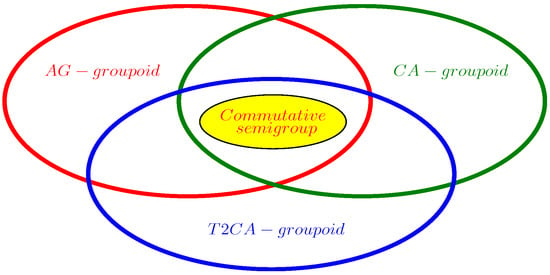
Figure 1.
The relationships among the AG-groupoid, CA-groupoid and T2CA-groupoid.
In Figure 1, there are three large colored oval circles and a small yellow ellipse. The large oval circles of different colors represent different groupoids. The red oval circle represents the AG-groupoid, the green oval circle represents CA-groupoid; the blue oval circle represents the T2CA-groupoid; and the small yellow one at the intersection of the three large oval circles represents the commutative semigroup. From Figure 1, we can see that the commutative semigroup is indeed a special kind of groupoid which not only satisfies the left invertive law but also satisfies the cyclic associative law and the type-2 cyclic associative law.
Research on the various cancellativities of semigroups has always been an active research field (see [14,15,16,17,18,19,20,21,22,23,24]). By using the research method of cancellativities of semigroups, many important theoretical results about cancellativities have been obtained in different groupoids (see [2,25,26,27]). In [2,27], Xiaohong Zhang et al. studied the various cancellativities of groupoids satisfying the two kinds of cyclic associative laws described above. However, there are still two open problems that have not been solved in [27]. In [2], only cancellativity has been studied, while the weak cancellativity, quasi-cancellativity and separativity of T2CA-groupoids have not been studied. As a continuation of [2,27], we fully address two open problems. Furthermore, the cancellativities of T2CA-groupoids are studied in detail.
The rest of this paper is arranged as follows. In Section 2, some definitions and properties on the CA-groupoid and T2CA-groupoid are given. We study the relationships between the T2CA-groupoid and other groupoids in Section 3. The quasi-cancellativity and cancellativity of CA-groupoids are discussed in Section 4. We discuss the quasi-cancellativity and cancellativity of T2CA-groupoids and study the relationships between them in Section 5. Finally, Section 6 presents some conclusions and the direction of future efforts.
2. Preliminaries
This section introduces the basic concepts and related research results of the CA-groupoid and T2CA-groupoid.
In general, different groupoids are defined according to the properties of binary operation defined on groupoids. For example, the groupid is semigroup if the operation satisfies the associative law. If it satisfies the left invertive law, the groupid is AG-groupoid. If it satisfies the cyclic associative law, the groupid is CA-groupoid. The cyclic associative AG-groupoid, which is a subclass of AG-groupoid, satisfies both the left invertive law and the cyclic associative law (see [10]).
Proposition 1
([28]). If is a CA-groupoid, then for all , .
Proposition 2
([28]). Every commutative CA-groupoid is a commutative semigroup.
Corollary 1
([27]). Right cancellativity and cancellativity in a CA-groupoid are equivalent.
Definition 1
([27]). A CA-groupoid has weak cancellativity if for all , and imply .
Definition 2
([27]). A CA-groupoid has left separativity if for all , and imply .
Definition 3
([27]). A CA-groupoid has right separativity if for all , and imply .
A CA-groupoid has separativity if it has both left separativity and right separativity.
Corollary 2
([27]). Left separativity, right separativity and separativity in a CA-groupoid are equivalent.
Definition 4
([27]). A CA-groupoid has left quasi-cancellativity if for all , and imply .
Definition 5
([27]). A CA-groupoid has right quasi-cancellativity if for all , and imply .
A CA-groupoid has quasi-cancellativity if it has both left quasi-cancellativity and right quasi-cancellativity.
Proposition 3
([27]). In a CA-groupoid, cancellativity is separativity.
Corollary 3
([27]). A CA-groupoid with cancellativity is a commutative CA-groupoid.
Theorem 1
([27]). In a CA-groupoid, separativity is quasi-cancellativity.
Theorem 2
([27]). In a CA-groupoid, left quasi-cancellativity is right quasi-cancellativity.
Definition 6
([27]). A CA-groupoid is called a CA-3-band, if for all , .
Theorem 3
([27]). Every CA-3-band has quasi-cancellativity.
A groupoid is called a T2CA-groupoid if it holds the type-2 cyclic associative law, that is, for all
Proposition 4
([2]). If is a T2CA-groupoid, then for all , .
Proposition 5
([2]). Every commutative T2CA-groupoid is a commutative semigroup.
3. The Relationships between T2CA-Groupoid and Other Groupoids
In this section, we further study the relationships between the T2CA-groupoid and other groupoids based on the research in [2].
In a T2CA-groupoid , for all , , the groupoid is called monoassociative. It is readily verified that every T2CA-groupoid is monoassociative. Because T2CA-groupoid is monoassociative, it also has the following result similar to the finite semigroup.
Theorem 4.
Let be a finite T2CA-groupoid. Then, . That is, there exists an idempotent element in G.
Proof.
Suppose that a T2CA-groupoid is finite. Then, for all , . Since G is finite, there exist such that . According to the value of i and j, we will discuss this in three cases.
Case 1: if , then , that is, , is the idempotent element we are looking for.
Case 2: if , then from , we have
.
This means that is the idempotent element we are looking for.
Case 3: if , then from we have
;
;
.
Since then . For , Case 3 becomes Case 1 when and Case 3 becomes Case 2 when . Therefore, we can find an idempotent element in G. □
In [2], the commutative T2CA-groupoid is shown to be a commutative semigroup (see Proposition 5). We can easily prove the following three conclusions: the associative T2CA-groupoid is a CA-groupoid; the T2CA-groupoid that satisfies the cyclic associative law is a semigroup; and the associative CA-groupoid is a T2CA-groupoid. Therefore, the relationships between the T2CA-groupoid, CA-groupoid and semigroup are shown in Figure 2.
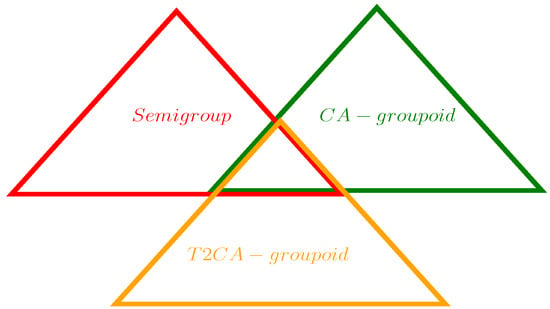
Figure 2.
The relationships among the T2CA-groupoid, CA-groupoid and semigroup.
In Figure 2, there are three triangles of different colors. The red triangle represents the semigroup; the green triangle represents the CA-groupoid; and the orange triangle represents the T2CA-groupoid. We can see from Figure 2 that between the three algebraic structures—the semigroup, CA-groupoid and T2CA-groupoid—the intersection of any two is the proper subset of the third.
Example 1 shows that there is a T2CA-groupoid which is neither an AG-groupoid, nor a CA-groupoid, nor a semigroup.
Example 1.

Given , we define the operation ∗ on G as shown in Table 1. G is a T2CA-groupoid. However, , and ; thus, G is neither an AG-groupoid, nor a CA-groupoid, nor a semigroup.

Table 1.
A T2CA-groupoid of Example 1.
Theorem 5.
Let be a T2CA-groupoid. Then, G is a CA-groupoid iff for all , .
Proof.
Suppose that is a T2CA-groupoid with the cyclic associative law. For all we have
In contrast, if is a T2CA-groupoid and for all , we have
Since the cyclic associative law holds, G is a CA-groupoid. □
Theorem 6.
Let be a T2CA-groupoid. Then, G is an AG-groupoid iff for all , .
Proof.
Suppose that is a T2CA-groupoid with the left invertive law. For all we have
In contrast, if is a T2CA-groupoid and for all , we have
Since the left invertive law holds, G is an AG-groupoid. □
4. Quasi-Cancellativity and Cancellativity of CA-Groupoids
In this section, we prove two theorems that weak cancellativity is cancellativity and right quasi-cancellativity is left quasi-cancellativity in a CA-groupoid, thus successfully solving two open problems.
Zhirou Ma et al. [27] proved that cancellativity is weak cancellativity in a CA-groupoid and proposed an open problem: “Is weak cancellativity necessarily cancellativity in a CA-groupoid?” We tried to look for such an example by computer programming in finite weak cancellative CA-groupoids, which is not a cancellative CA-groupoid. However, it was not found. We therefore considered another possibility, namely that weak cancellativity is cancellativity in a CA-groupoid. Fortunately, this conjecture can be proven to be correct.
Theorem 7.
Weak cancellativity is cancellativity in a CA-groupoid.
Proof.
Suppose that is a CA-groupoid with weak cancellativity. For all if , then
Similarly, we have and
That is, . With , , by Definition 1, we can obtain . From this and , by Definition 1 again, . Thus, has right cancellativity. According to Corollary 1, it follows that weak cancellativity is cancellativity in a CA-groupoid. □
Corollary 4.
Weak cancellativity and cancellativity are equivalent in a CA-groupoid.
Proof.
This is a corollary to Theorem 7. □
In [27], left quasi-cancellativity in a CA-groupoid is proven to be right quasi-cancellativity. At the same time, another open problem was asked: “Is right quasi-cancellativity necessarily left quasi-cancellativity in a CA-groupoid?” After careful argumentation, we made clear the relationship between left quasi-cancellativity and right quasi-cancellativity in a CA-groupoid and answered this open problem.
Theorem 8.
Right quasi-cancellativity is left quasi-cancellativity in a CA-groupoid.
Proof.
Suppose that is a CA-groupoid with right quasi-cancellativity. For all if and , then
From this and by Definition 5, we can obtain . Therefore, based on the existing assumptions and , we have and . By Definition 5 again, we obtain that . Thus, by Definition 4 has left quasi-cancellativity. □
Corollary 5.
Left quasi-cancellativity, right quasi-cancellativity and quasi-cancellativity in a CA-groupoid are equivalent to each other.
Proof.
This is the corollary of Theorems 2 and 8. □
Given that the relationships among separativity, quasi-cancellativity and commutativity in a CA-groupoid were not discussed in previous literature, we will now discuss their relationships.
Theorem 9.
A CA-groupoid with separativity is a commutative CA-groupoid.
Proof.
We first proved that a CA-groupoid with right separativity is a commutative CA-groupoid. Suppose that is a CA-groupoid with right separativity. For all we have
From this and by Definition 3, we can obtain . Therefore, is a commutative CA-groupoid. According to Corollary 2, it follows that a CA-groupoid with separativity is a commutative CA-groupoid. □
Obviously, Corollary 3 can be derived from Proposition 3 and Theorem 9.
Example 2 illustrates that a quasi-cancellative CA-groupoid is not always a commutative CA-groupoid.
Example 2.

Given , we define the operation ∗ on G as shown in Table 2. G is a quasi-cancellative CA-groupoid. However, . G is not a commutative CA-groupoid.

Table 2.
A quasi-cancellative CA-groupoid of Example 2.
Example 3 illustrates that a commutative CA-groupoid is not always a quasi-cancellative CA-groupoid.
Example 3.

Given , we define the operation ∗ on G as shown in Table 3. G is a commutative CA-groupoid. However, and . G is not a quasi-cancellative CA-groupoid.

Table 3.
A commutative CA-groupoid of Example 3.
Example 4 illustrates that a commutative CA-groupoid with quasi-cancellativity is not always a separative CA-groupoid.
Example 4.

Given , we define the operation ∗ on G as shown in Table 4. G is a commutative CA-groupoid with quasi-cancellativity. However, and . G is not a separative CA-groupoid.

Table 4.
A commutative CA-groupoid with quasi-cancellativity of Example 4.
From Theorems 1 and 9, as well as Examples 2–4, we have Figure 3.
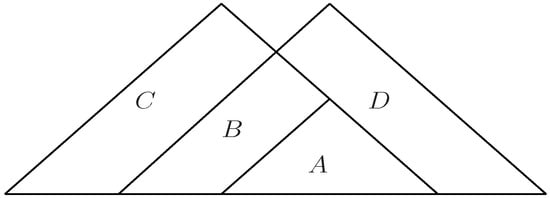
Figure 3.
The relationships among the quasi-cancellative CA-groupoid, separative CA-groupoid and commutative CA-groupoid.
Figure 3 shows the relationships among the quasi-cancellative CA-groupoid, separative CA-groupoid and commutative CA-groupoid. Here, A stands for separative CA-groupoid; B stands for commutative CA-groupoid with quasi-cancellativity, as shown in Example 4, rather than a separative CA-groupoid; C stands for quasi-cancellative CA-groupoid, as shown in Example 2, rather than the commutative CA-groupoid; and D stands for commutative CA-groupoid, as shown in Example 3, rather than quasi-cancellative CA-groupoid. A + B + C stands for quasi-cancellative CA-groupoid; and A + B + D stands for commutative CA-groupoid.
In [27], Zhirou Ma et al. proved that separativity is quasi-cancellativity in a CA-groupoid and every CA-3-band has quasi-cancellativity (see Theorems 1 and 3). The relationship between the CA-3-band and separativity is given in the following Theorem 10.
Theorem 10.
Let be a CA-3-band. Then:
- (1)
- G has separativity;
- (2)
- G is a commutative semigroup.
Proof.
(1) Suppose that is a CA-3-band. We first prove that the CA-3-band has left separativity. For all we have and . If and , then
Therefore, has left separativity. According to Corollary 2, it follows that has separativity.
(2) This is the corollary of Theorem 9 and Proposition 2. □
By the definition of the CA-3-band (see Definition 6), we know that a CA-groupoid needs two conditions and to become a CA-3-band. It can be seen from the following Proposition 6 that only one condition ( or ) is required.
Proposition 6.
Let be a CA-groupoid. Then, for all , iff .
Proof.
Suppose that is a CA-groupoid. For all , we have
In contrast, if is a CA-groupoid and for all , we have
□
5. Quasi-Cancellativity and Cancellativity of T2CA-Groupoids
In this section, we discuss the quasi-cancellativity and cancellativity of T2CA-groupoids and study the relationships between them.
Definition 7
([2]). A T2CA-groupoid is called a left cancellative T2CA-groupoid if for all , implies that .
Definition 8
([2]). A T2CA-groupoid is called a right cancellative T2CA-groupoid if for all , implies that .
A groupoid is called a cancellative T2CA-groupoid if it is both a left cancellative T2CA-groupoid and a right cancellative T2CA-groupoid.
Corollary 6
([2]). A left cancellative T2CA-groupoid, a right cancellative T2CA-groupoid and a cancellative T2CA-groupoid are equivalent to each other.
Definition 9.
A T2CA-groupoid is called a weak cancellative T2CA-groupoid if for all , and imply that .
Example 5.

Given , we define the operation ∗ on G as shown in Table 5. By Definition 9, G is a weak cancellative T2CA-groupoid.

Table 5.
A weak cancellative T2CA-groupoid of Example 5.
Theorem 11.
A weak cancellative T2CA-groupoid is a cancellative T2CA-groupoid.
Proof.
Suppose that is a weak cancellative T2CA-groupoid. For all if , then
That is, and . Since , by Definition 9, we can obtain . From this and , by Definition 9 again, . Thus, by Definition 8 is a right cancellative T2CA-groupoid. By Corollary 6, we know that a weak cancellative T2CA-groupoid is a cancellative T2CA-groupoid. □
Corollary 7.
A weak cancellative T2CA-groupoid is equal to a cancellative T2CA-groupoid.
Proof.
This is a corollary to Theorem 11. □
Corollary 8.
Every cancellative T2CA-groupoid is a commutative T2CA-groupoid.
Proof.
Suppose that is a cancellative T2CA-groupoid. For all we have
By cancellative law, we can obtain . Therefore, G is a commutative T2CA-groupoid. □
Definition 10.
A T2CA-groupoid is called a power cancellative T2CA-groupoid for all , if implies .
Corollary 9.
Every power cancellative T2CA-groupoid is a commutative T2CA-groupoid.
Proof.
Suppose that is a power cancellative T2CA-groupoid. For all we have
By Definition 10, we can obtain . Therefore, G is a commutative T2CA-groupoid. □
Example 6 illustrates that a T2CA-groupoid can be both a power cancellative T2CA-groupoid and a cancellative T2CA-groupoid.
Example 6.

Since , we define the operation ∗ on G as shown in Table 6. G is both a power cancellative T2CA-groupoid and a cancellative T2CA-groupoid.

Table 6.
A T2CA-groupoid with both power cancellativity and the cancellativity of Example 6.
Example 7 illustrates that a power cancellative T2CA-groupoid is not always a cancellative T2CA-groupoid.
Example 7.

Since , we define the operation ∗ on G as shown in Table 7. G is a power cancellative T2CA-groupoid. However, and ; thus, G is not a cancellative T2CA-groupoid.

Table 7.
A power cancellative T2CA-groupoid of Example 7.
Example 8 illustrates that a cancellative T2CA-groupoid is not always a power cancellative T2CA-groupoid.
Example 8.

Given , we define the operation ∗ on G as shown in Table 8. G is a cancellative T2CA-groupoid. However, and ; thus, G is not a power cancellative T2CA-groupoid.

Table 8.
A cancellative T2CA-groupoid of Example 8.
Definition 11.
A T2CA-groupoid is called a left separative T2CA-groupoid for all if and imply .
Definition 12.
A T2CA-groupoid is called a right separative T2CA-groupoid for all if and imply .
A groupoid is called a separative T2CA-groupoid, if it is both a left separative T2CA-groupoid and a right separative T2CA-groupoid.
Definition 13.
A T2CA-groupoid is called a quasi-separative T2CA-groupoid for all if implies .
Theorem 12.
Let be a T2CA-groupoid. Then, in this case, the following four statements are equivalent:
- (1)
- G is a left separative T2CA-groupoid;
- (2)
- G is a separative T2CA-groupoid;
- (3)
- G is a right separative T2CA-groupoid;
- (4)
- G is a quasi-separative T2CA-groupoid.
Proof.
(1)⇒(2). Suppose that is a left separative T2CA-groupoid. For all if and , then
By Definition 11, we obtain that . Therefore, based on the existing assumptions and , we have and . By Definition 11, we again have . Thus, from Definition 12, is a right separative T2CA-groupoid. is both a left and right separative, so it is a separative T2CA-groupoid.
(2)⇒(3). Obviously.
(3)⇒(4). Suppose that is a right separative T2CA-groupoid. For all if , then
By Definition 12, we obtain that . Therefore, based on the existing assumptions , we have and . By Definition 12 again, we have . Thus, from Definition 13, is a quasi-separative T2CA-groupoid.
(4)⇒(1). Suppose that is a quasi-separative T2CA-groupoid. For all if and , then
That is . By Definition 13, we obtain that . Therefore, based on the existing assumptions and , we have . By Definition 13, we again have . Thus, from Definition 11, is a left separative T2CA-groupoid. □
Theorem 13.
A cancellative T2CA-groupoid is a separative T2CA-groupoid.
Proof.
Suppose that is a cancellative T2CA-groupoid. For all if and , then from cancellative law, we have . Thus, is a left separative T2CA-groupoid. By Theorem 12, we can obtain that is a separative T2CA-groupoid. □
Theorem 14.
A power cancellative T2CA-groupoid is a separative T2CA-groupoid.
Proof.
Suppose that is a power cancellative T2CA-groupoid. For all if , then from power cancellative law, we have . Thus, is a quasi-separative T2CA-groupoid. By Theorem 12, we can determine that is a separative T2CA-groupoid. □
Example 9 illustrates that a separative T2CA-groupoid is neither a power cancellative T2CA-groupoid nor a cancellative T2CA-groupoid.
Example 9.

Since , we define operation * on G as shown in Table 9. G is a separative T2CA-groupoid. However, , and ; thus, G is neither a power cancellative T2CA-groupoid nor a cancellative T2CA-groupoid.

Table 9.
A separative T2CA-groupoid of Example 9.
Definition 14.
A T2CA-groupoid is called a left quasi-cancellative T2CA-groupoid for all if and which imply that .
Definition 15.
A T2CA-groupoid is called a right quasi-cancellative T2CA-groupoid for all if and imply that .
A groupoid is called a quasi-cancellative T2CA-groupoid if it is both a left quasi-cancellative T2CA-groupoid and a right quasi-cancellative T2CA-groupoid.
Theorem 15.
Let be a T2CA-groupoid. Then, in this case, the following three statements are equivalent:
- (1)
- G is a left quasi-cancellative T2CA-groupoid;
- (2)
- G is a quasi-cancellative T2CA-groupoid;
- (3)
- G is a right quasi-cancellative T2CA-groupoid.
Proof.
(1)⇒(2). Suppose that is a left quasi-cancellative T2CA-groupoid. For all if and , then
According to the above derivation, we can obtain . Therefore, based on the existing assumptions and , we have and . By Definition 14, we obtain that . Thus, from Definition 15, is a right quasi-cancellative T2CA-groupoid. has both left and right quasi-cancellativity, so it is a quasi-cancellative T2CA-groupoid.
(2)⇒(3). This is evident.
(3)⇒(1). Suppose is a right quasi-cancellative T2CA-groupoid. For all if and , then
According to the above derivation, we can determine that . Therefore, based on the existing assumptions and , we have and . By Definition 15, we obtain that . Thus, from Definition 14, is a left quasi-cancellative T2CA-groupoid. □
Theorem 16.
A separative T2CA-groupoid is a quasi-cancellative T2CA-groupoid.
Proof.
First, we prove that a quasi-separative T2CA-groupoid is a right quasi-cancellative T2CA-groupoid. Suppose is a quasi-separative T2CA-groupoid. For all if and , then
We can obtain . By Definition 13, we determine that . Thus, a quasi-separative T2CA-groupoid is a right quasi-cancellative T2CA-groupoid. According to Theorem 12 and Theorem 15, it follows that a separative T2CA-groupoid is a quasi-cancellative T2CA-groupoid. □
Example 10 illustrates that a quasi-cancellative T2CA-groupoid is not always a separative T2CA-groupoid.
Example 10.

Since , we define the operation ∗ on G as shown in Table 10. G is a quasi-cancellative T2CA-groupoid. However, and . G is not a separative T2CA-groupoid.

Table 10.
A quasi-cancellative T2CA-groupoid of Example 10.
Figure 4 shows the relationships between the separative T2CA-groupoid and quasi-cancellative T2CA-groupoid. There are four ellipses of different colors and sizes in the picture.
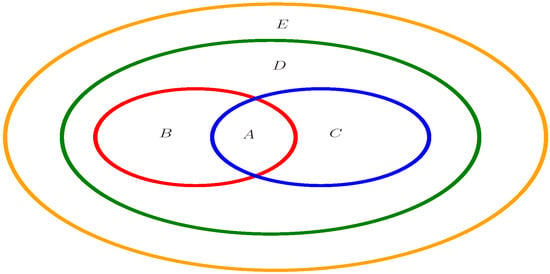
Figure 4.
The relationships between the separative T2CA-groupoid and quasi-cancellative T2CA-groupoid.
A stands for both the power cancellative T2CA-groupoid and cancellative T2CA-groupoid shown in Example 6; B stands for the power cancellative T2CA-groupoid shown in Example 7 rather than the cancellative T2CA-groupoid; C stands for the cancellative T2CA-groupoid shown in Example 8 rather than the power cancellative T2CA-groupoid; D stands for the separative T2CA-groupoid shown in Example 9, which is, however, neither a power cancellative T2CA-groupoid nor a cancellative T2CA-groupoid; and E stands for the quasi-cancellative T2CA-groupoid shown in Example 10 rather than the separative T2CA-groupoid. A + B, which is the red ellipse, stands for the power cancellative T2CA-groupoid; A + C, which is the blue ellipse, stands for the cancellative T2CA-groupoid; A + B + C + D, which is the green ellipse, stands for the separative T2CA-groupoid; and A + B + C + D + E, which is the largest orange ellipse, stands for the quasi-cancellative T2CA-groupoid.
Theorem 17.
Let be a separative T2CA-groupoid. Then, G is a commutative T2CA-groupoid if for all there exists such that .
Proof.
Suppose that is a separative T2CA-groupoid, then by Theorem 12, is a quasi-separative T2CA-groupoid. For all if there exists such that . Since the T2CA-groupoid is monoassociative, we have . We can determine that
That is . By Definition 13, we have . Thus, G is a commutative T2CA-groupoid. □
Example 11.

Given , we define the operation ∗ on G as shown in Table 11. G is a separative T2CA-groupoid. For any , without losing generality, let , and we can obtain . Since , the other cases can be verified. By Theorem 17, G is a commutative T2CA-groupoid.

Table 11.
A separative T2CA-groupoid of Example 11.
Definition 16.
A T2CA-groupoid is called a T2CA-band if for all , .
Corollary 10.
Every T2CA-band is a power cancellative T2CA-groupoid.
Proof.
This is evident. □
Definition 17.
A T2CA-groupoid is called a T2CA-3-band if for all , .
Theorem 18.
Let be a T2CA-3-band. Then:
- (1)
- G is a commutative semigroup; and
- (2)
- G is a separative T2CA-groupoid.
Proof.
(1) Suppose that is a T2CA-3-band. For all we have and . Then,
Therefore, G is a commutative T2CA-groupoid. By Proposition 5, G is a commutative semigroup.
(2) Suppose that is a T2CA-3-band. We first prove that a T2CA-3-band is a quasi-separative T2CA-groupoid. For all we have and . If , then
Therefore, is a quasi-separative T2CA-groupoid. According to Theorem 12, it follows that every T2CA-3-band is a separative T2CA-groupoid. □
6. Conclusions
Using the research methods of cancellativities in semigroups, we mainly investigated the properties of weak cancellativity, separativity and quasi-cancellativity on T2CA-groupoids. Some important results were obtained which can assist further study of the structure of T2CA-groupoids. We prove that the left quasi-cancellative T2CA-groupoid, right quasi-cancellative T2CA-groupoid and quasi-cancellative T2CA-groupoid are equivalent (see Theorem 15); that the left separative T2CA-groupoid, right separative T2CA-groupoid, quasi-separative T2CA-groupoid and separative T2CA-groupoid are equivalent (see Theorem 12); and that the weak cancellative T2CA-groupoid and cancellative T2CA-groupoid are equivalent (see Corollary 7). Figure 5 shows the main results on the T2CA-groupoid in this paper.
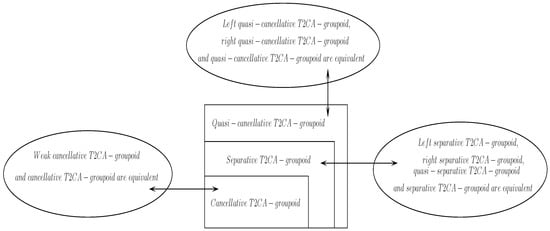
Figure 5.
The main results obtained for the T2CA-groupoid in this paper.
Furthermore, we successfully solve two open problems in [27]. We prove that weak cancellativity is cancellativity and right quasi-cancellativity is left quasi-cancellativity in a CA-groupoid (see Theorems 7 and 8). The relationships among separativity, quasi-cancellativity and commutativity in a CA-groupoid were discussed (see Figure 3), thus clarifying the structure of a CA-groupoid. Figure 6 shows the main results obtained for the CA-groupoid in this paper.
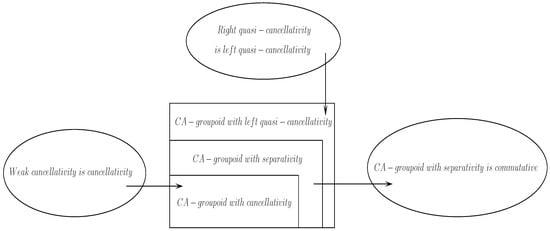
Figure 6.
The main results obtained for the CA-groupoid in this paper.
Finally, we investigate the relationships between the T2CA-groupoid and other groupoids (see Figure 2). The necessary and sufficient conditions for the T2CA-groupoid to be the CA-groupoid and the necessary and sufficient conditions for the T2CA-groupoid to be the AG-groupoid are given (see Theorems 5 and 6). In future research, we will investigate the relationships between the T2CA-groupoid and other groupoids and the related logic algebras (as can be seen in [29,30,31,32]).
Author Contributions
Conceptualization, X.Z.; funding acquisition, X.Z.; resources, data curation and software, X.A.; writing—original draft, writing—review and editing, X.A. and Z.M. All authors have read and agreed to the published version of the manuscript.
Funding
This research was supported by the National Natural Science Foundation of China (Grant No. 62081240416).
Institutional Review Board Statement
Not applicable.
Informed Consent Statement
Not applicable.
Data Availability Statement
Not applicable.
Conflicts of Interest
The authors declare no conflict of interest.
References
- Kazim, M.; Naseeruddin, M. On almost semigroups. Aligarh Bull. Math. 1972, 2, 1–7. [Google Scholar]
- Zhang, X.; Yuan, W.; Chen, M. A kind of non-associative groupoids and quasi neutrosophic extended triplet groupoids (QNET-groupoids). Neutrosophic Sets Syst. 2020, 36, 144–163. [Google Scholar]
- Hosszú, M. Some functional equations related with the associative law. Publ. Math. Debrecen 1954, 3, 205–214. [Google Scholar]
- Maksa, G. CM solutions of some functional equations of associative type. Annales Univ. Sci. Budapest. Sect. Comp. 2004, 24, 125–132. [Google Scholar]
- Schölzel, K.; Tomaschek, J. Power series solutions of Tarski’s associativity law and of the cyclic associativity law. Aequationes Math. 2016, 90, 411–425. [Google Scholar] [CrossRef]
- Kleinfeld, M. Rings with x(yz) = y(zx). Commun. Algebra 1995, 23, 5085–5093. [Google Scholar] [CrossRef]
- Behn, A.; Correa, I.; Hentzel, I.R. Semiprimality and nilpotency of nonassociative rings satisfying x(yz) = y(zx). Commun. Algebra 2008, 36, 132–141. [Google Scholar] [CrossRef]
- Samanta, D.; Hentzel, I.R. Nonassociative rings satisfying a(bc) = b(ca) and (a, a, b) = (b, a, a). Commun. Algebra 2019, 47, 3915–3920. [Google Scholar] [CrossRef]
- Behn, A.; Correa, I.; Hentzel, I.R. On flexible algebras satisfying x(yz) = y(zx). Algebra Colloq. 2010, 17, 881–886. [Google Scholar] [CrossRef]
- Iqbal, M.; Ahmad, I.; Shah, M.; Ali, M.I. On cyclic associative Abel-Grassman groupoids. Br. J. Math. Comput. Sci. 2016, 12, 1–16. [Google Scholar] [CrossRef]
- Iqbal, M.; Ahmad, I. On further study of CA-AG-groupoids. Proc. Pak. Acad. Sci. A Phys. Comput. Sci. 2016, 53, 325–337. [Google Scholar]
- Iqbal, M.; Ahmad, I. Ideals in CA-AG-groupoids. Indian J. Pure Appl. Math. 2018, 49, 265–284. [Google Scholar] [CrossRef]
- Iqbal, M.; Ahmad, I. Some congruences on CA-AG-groupoids. Punjab Univ. J. Math. 2019, 51, 71–87. [Google Scholar]
- Tamura, T. Commutative nonpotent archimedean semigroup with cancelation law I. J. Gakugei Tokushima Univ. 1957, 8, 5–11. [Google Scholar]
- Burmistrovich, I.E. Commutative bands of cancellative semigroups. Sib. Mat. Zhurnal 1965, 6, 284–299. [Google Scholar]
- Grillet, P.A. Cancellative commutative semigroups. Semigroup Forum 1970, 1, 249–253. [Google Scholar] [CrossRef]
- Neumann, B.H. Some remarks on cancellative semigroups. Math. Z. 1970, 117, 97–111. [Google Scholar] [CrossRef]
- Hamilton, H.B.; Nordahl, T.E.; Tamura, T. Commutative cancellative semigroups without idempotents. Pac. J. Math. 1975, 61, 441–456. [Google Scholar] [CrossRef]
- Goodearl, K.R. Power-cancellation of groups and modules. Pac. J. Math. 1976, 64, 387–411. [Google Scholar] [CrossRef][Green Version]
- Spoletini, A.C.; Varisco, A. Power cancellative semigroups. Semigroup Forum 1979, 18, 381–384. [Google Scholar] [CrossRef]
- Cegarra, A.M.; Petrich, M. The rank of a commutative cancellative semigroup. Acta Math. Hung. 2005, 107, 71–75. [Google Scholar]
- Krasilnikova, Y.I.; Novikov, B.V. On quasi-separative semigroups. Semigroup Forum 2005, 70, 347–355. [Google Scholar] [CrossRef][Green Version]
- Cegarra, A.M.; Petrich, M. Commutative cancellative semigroups of low rank. Results Math. 2009, 54, 41–52. [Google Scholar] [CrossRef]
- Petrich, M. Malcev products of weakly cancellative monoids and varieties of bands. Semigroup Forum 2015, 90, 339–373. [Google Scholar] [CrossRef]
- Shah, M.; Shah, T.; Ali, A. On the cancellativity of AG-groupoids. Int. Math. Forum 2011, 6, 2187–2194. [Google Scholar]
- Shah, M.; Ahmad, I.; Ali, A. On quasi-cancellativity of AG-groupoids. Int. J. Contemp. Math. Sci. 2012, 7, 2065–2070. [Google Scholar]
- Ma, Z.; Zhang, X.; Smarandache, F. Some results on various cancellative CA-groupoids and variant CA-groupoids. Symmetry 2020, 12, 315. [Google Scholar] [CrossRef]
- Zhang, X.; Ma, Z.; Yuan, W. Cyclic associative groupoids (CA-Groupoids) and cyclic associative neutrosophic extended triplet groupoids (CA-NET-groupoids). Neutrosophic Sets Syst. 2019, 29, 19–29. [Google Scholar]
- Zhang, X.; Du, Y. Left (right) regular and transposition regular semigroups and their structures. Mathematics 2022, 10, 1021. [Google Scholar] [CrossRef]
- Zhang, X.; Du, Y. A class of BCI-Algebra and quasi-hyper BCI-Algebra. Axioms 2022, 11, 72. [Google Scholar] [CrossRef]
- Du, Y.; Zhang, X. QM-BZ-algebras and quasi-hyper BZ-algebras. Axioms 2022, 11, 93. [Google Scholar] [CrossRef]
- Hu, M.; Zhang, X. On cyclic associative semihypergroups and neutrosophic extended triplet cyclic associative semihypergroups. Mathematics 2022, 10, 535. [Google Scholar] [CrossRef]
Publisher’s Note: MDPI stays neutral with regard to jurisdictional claims in published maps and institutional affiliations. |
© 2022 by the authors. Licensee MDPI, Basel, Switzerland. This article is an open access article distributed under the terms and conditions of the Creative Commons Attribution (CC BY) license (https://creativecommons.org/licenses/by/4.0/).